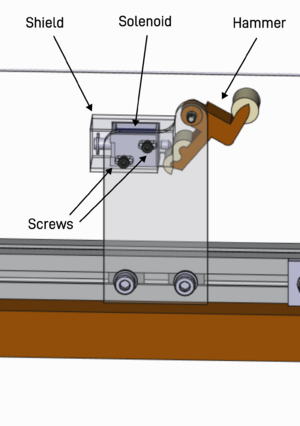The Ekdahl FAR - Hammer: Difference between revisions
No edit summary |
No edit summary |
||
| Line 11: | Line 11: | ||
The concept of ''mechanical latency'' is that when for instance playing a key on a piano, it will indeed take a moment from key press to the hammer hitting the string. Even tho this makes physical sense, the concept of ''mechanical latency'' came as a bit of a surprise in being an issue with the Ekdahl FAR. To make matters worse, the ''mechanical latency'' of the ''hammer'' is dependent on the force of the hammer hit - higher force means faster speed of the ''hammer'' resulting in the delay in between the ''solenoid'' activation and sound produced being reduced. For this reason, quieter ''hammer'' hits always have higher ''mechanical latency'' than louder ones. This may sound like a bad thing but in reality this would be the case for any acoustic piano as well (for instance). | The concept of ''mechanical latency'' is that when for instance playing a key on a piano, it will indeed take a moment from key press to the hammer hitting the string. Even tho this makes physical sense, the concept of ''mechanical latency'' came as a bit of a surprise in being an issue with the Ekdahl FAR. To make matters worse, the ''mechanical latency'' of the ''hammer'' is dependent on the force of the hammer hit - higher force means faster speed of the ''hammer'' resulting in the delay in between the ''solenoid'' activation and sound produced being reduced. For this reason, quieter ''hammer'' hits always have higher ''mechanical latency'' than louder ones. This may sound like a bad thing but in reality this would be the case for any acoustic piano as well (for instance). | ||
In order for the user to be able to change both the velocity and ''latency'' of the ''hammer'', the ''hammer'' | In order for the user to be able to change both the velocity and ''latency'' of the ''hammer'', the ''hammer'' is adjustable. Certain strings, namely thinner ones, can produce heavy distortion if hit too hard. | ||
Latest revision as of 13:13, 24 January 2025
Technical details

The hammer on the Ekdahl FAR generally doesn't need adjustment and the mechanism is quite straight forward, however for completion and to be thorough this information is included.
The hammer on the Ekdahl FAR is actuated through the use of a solenoid. The solenoid being an electromagnetic device, it is encased in a shield in order to avoid electromagnetic interference traveling into the pickup creating audible clicks and pops.
The solenoid and shield can be moved sideways by loosening two screws, this sets the amount of travel that the hammer has from its resting position until it touches the string. Increasing the travel of the hammer increases the force of the hammer hit against the string as the hammer has more time to accelerate, however it also increases the time from solenoid activation to the hammer hitting the string, effectively increasing mechanical latency.
Most musicians that have dealt with digital recording recognize the concept of latency as being a "lag" when for instance playing a MIDI keyboard with a software synth; at times there can be a noticeable delay in between key press and sound.
The concept of mechanical latency is that when for instance playing a key on a piano, it will indeed take a moment from key press to the hammer hitting the string. Even tho this makes physical sense, the concept of mechanical latency came as a bit of a surprise in being an issue with the Ekdahl FAR. To make matters worse, the mechanical latency of the hammer is dependent on the force of the hammer hit - higher force means faster speed of the hammer resulting in the delay in between the solenoid activation and sound produced being reduced. For this reason, quieter hammer hits always have higher mechanical latency than louder ones. This may sound like a bad thing but in reality this would be the case for any acoustic piano as well (for instance).
In order for the user to be able to change both the velocity and latency of the hammer, the hammer is adjustable. Certain strings, namely thinner ones, can produce heavy distortion if hit too hard.